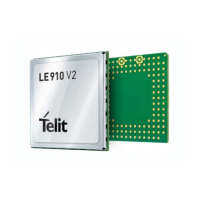Telit LE910 V2 Series AT Commands
80446ST10707A Rev. 0– 2015-11-03
Reproduction forbidden without Telit Communications S.p.A. written authorization - All Rights Reserved page 396 of 509
Mod. 0808 2011-07 Rev.2
#GPRS - GPRS Context Activation
Note: at least a socket identifier needs to be associated with PDP context #1 in
order to every #GPRS action be effective; by default the PDP context #1 is
associated with socket identifiers 1, 2 and 3, but it is possible to modify these
associations through #SCFG. Trying to issue a #GPRS action when no socket
identifier is associated with PDP context #1 raises an error.
Note: if the PDP context #1 has been activated issuing AT#GPRS=1, then
• if you request to deactivate the PDP context #1 during a call issuing
AT#GPRS=0 and then, after the call termination, you want to activate the PDP
context #1 again through #GPRS, you need to issue the following sequence of
three commands
AT#GPRS=1
OK
AT#GPRS=0
OK
AT#GPRS=1
OK
Note: this command is not allowed if GSM context has been activated (see
Read command reports the current status of the PDP context #1, in the format:
#GPRS: <status>
where:
<status>
0 - PDP context #1 deactivated
1 - PDP context #1 activated
2 - PDP context #1 activation pending.
Test command returns the allowed values for parameter <mode>.
+IP: 129.137.1.1
OK
Now PDP Context #1 has been activated and our IP is 129.137.1.1
AT#GPRS=0
OK
Now PDP Context #1 has been deactivated, IP is lost.
It is strongly recommended to use the same command (e.g. #GPRS) to activate the
context, deactivate it and interrogate about its status.

